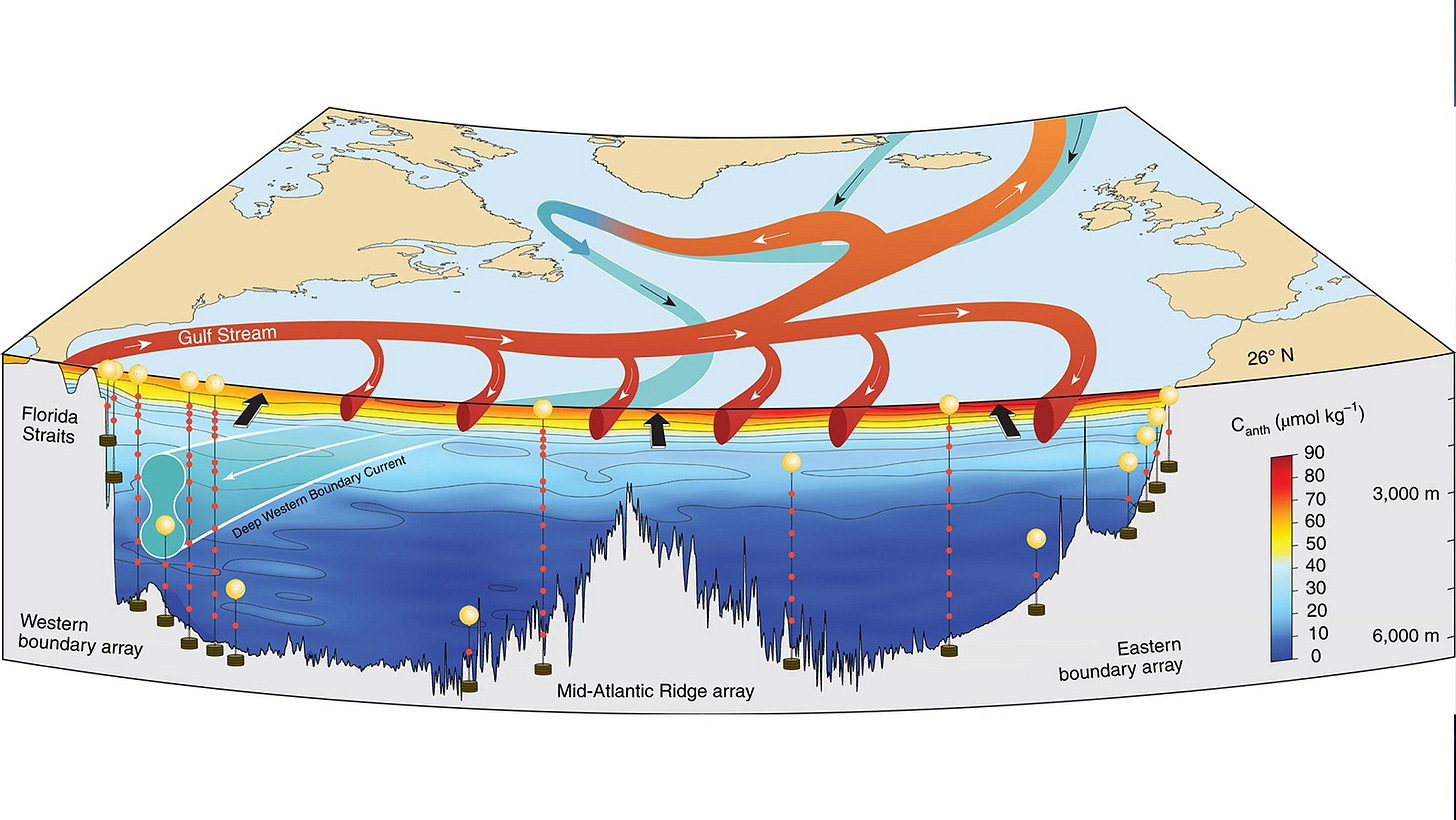AMOC: Models Say Collapse, Measurements Do Not
A new modeling paper says the Atlantic overturning may shut down after 2100. The real world measurements tell a different story.
First, what the AMOC actually is
Think of the Atlantic as a slow conveyor belt. Warm salty water flows north near the surface. Colder, heavier water sinks and returns south in the deep. This large-scale exchange is the Atlantic Meridional Overturning Circulation, or AMOC. It helps keep Western Europe mild, influences fish, storms, and the climate.
Oceanographers measure big currents in Sverdrups. One Sverdrup is equivalent to one million cubic meters of water per second. The AMOC at mid latitudes typically sits in the tens of Sverdrups. That is a lot of moving water.
How we measure it in the real ocean
Since 2004, an array of instruments across the Atlantic, near 26.5 degrees North, has monitored the overturning process day by day. This is the RAPID array. It estimates total northward flow near the surface, southward flow in the deep, and the heat carried north. There are other lines farther north, such as OSNAP, along with a simple but powerful record in the Florida Current, where a cable has tracked transport through the Straits of Florida since the early nineteen-eighties.
These are not guesses. They are instruments in the water.
What the instruments show
RAPID sees large natural swings from year to year. Over the full record, the trend is small and not statistically strong. The Florida Current record, which now spans four decades, shows no long-term decline.
The UK Met Office summary itself notes that OSNAP is too short to say anything firm about longer-term change. You can browse the Met Office AMOC page here for the same conclusion in plain words and pictures: Met Office AMOC.
So the best measurements we have do not show a collapse. They show variability.
Past articles on the AMOC
I have written on this many times. If you are new to this topic, start with AMOC 101. It is a plain-English tour of the Atlantic conveyor, why it matters for Europe’s climate, how it moves heat and carbon, and what the IPCC actually says about it. Spoiler: The IPCC states there is no observational evidence of an AMOC trend in the modern record. Read the article here.
Next, see AMOC Collapse? Think Again. I walk through the Florida Current measurements that have run for forty years and show a steady state in this major limb of the circulation. If you have only seen collapse headlines, this dataset will surprise you. Read more here.
Then sample my media autopsy, Examining the Most Newsworthy Climate Papers. It explains how a handful of dramatic studies get amplified while moderating evidence is ignored, and how that cycle turns model speculation into front-page certainty. Read the playbook here.
Read those three pieces first, then come back for today’s new modeling paper. You will spot the tricks immediately, and you will be ready for the figures and plain-language breakdown.
Read on for the full breakdown
Subscriber preview: below the paywall, I explain in plain language what the authors really did, why the thresholds they chose matter, and where they misread or misuse the observational literature. I show the RAPID observational data, quote the authors of the Florida Current paper, and also give a short primer on why climate models can be nudged to many different futures because the ocean and atmosphere are uncoupled nonlinear systems that are very sensitive to starting points and to the way small-scale processes are tuned.
If you want the annotated figures and the one-page cheat sheet you can share with friends, become a subscriber. You will also unlock more than 380 data-heavy articles that challenge the crisis narrative at IrrationalFear.com.
Keep reading with a 7-day free trial
Subscribe to Irrational Fear to keep reading this post and get 7 days of free access to the full post archives.



